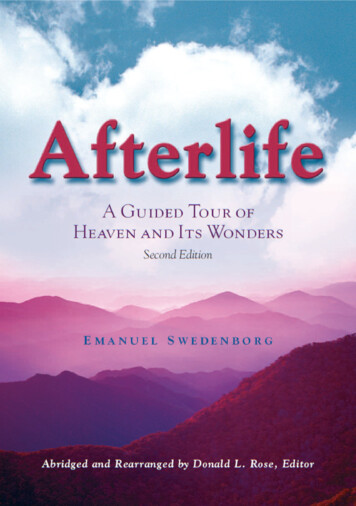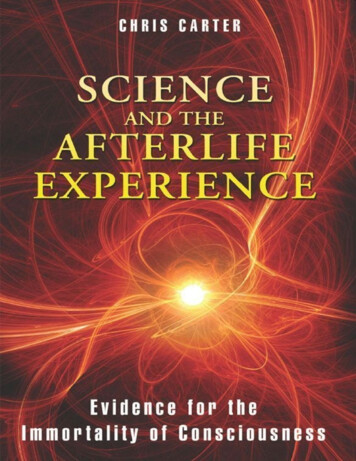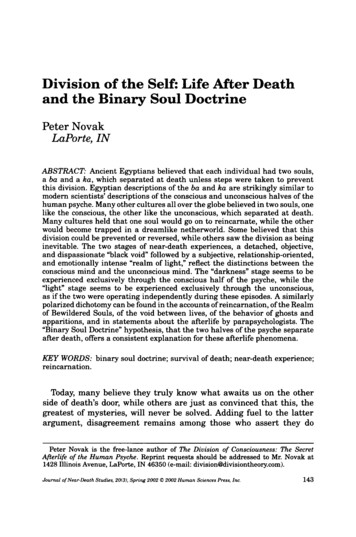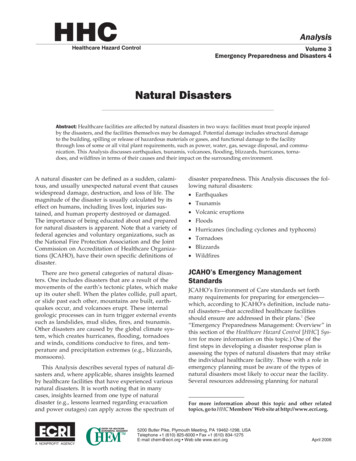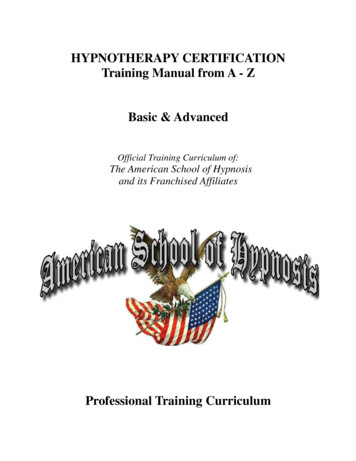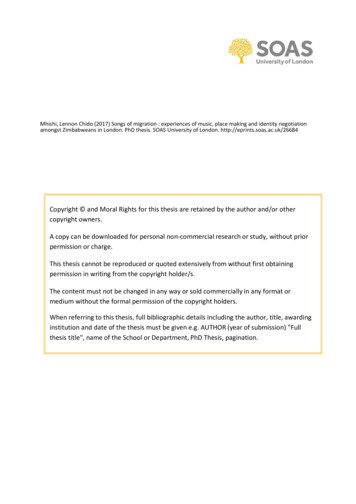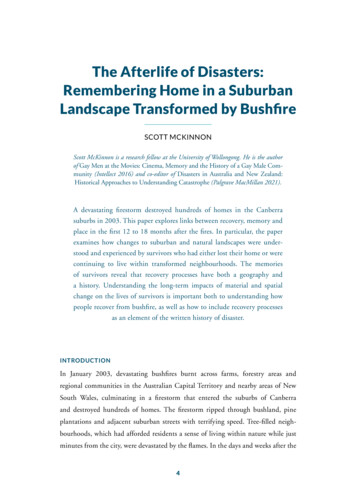
Transcription
The Afterlife of Disasters:Remembering Home in a SuburbanLandscape Transformed by BushfireSCOTT MCKINNONScott McKinnon is a research fellow at the University of Wollongong. He is the authorof Gay Men at the Movies: Cinema, Memory and the History of a Gay Male Community (Intellect 2016) and co-editor of Disasters in Australia and New Zealand:Historical Approaches to Understanding Catastrophe (Palgrave MacMillan 2021).A devastating firestorm destroyed hundreds of homes in the Canberrasuburbs in 2003. This paper explores links between recovery, memory andplace in the first 12 to 18 months after the fires. In particular, the paperexamines how changes to suburban and natural landscapes were understood and experienced by survivors who had either lost their home or werecontinuing to live within transformed neighbourhoods. The memoriesof survivors reveal that recovery processes have both a geography anda history. Understanding the long-term impacts of material and spatialchange on the lives of survivors is important both to understanding howpeople recover from bushfire, as well as how to include recovery processesas an element of the written history of disaster.INTRODUCTIONIn January 2003, devastating bushfires burnt across farms, forestry areas andregional communities in the Australian Capital Territory and nearby areas of NewSouth Wales, culminating in a firestorm that entered the suburbs of Canberraand destroyed hundreds of homes. The firestorm ripped through bushland, pineplantations and adjacent suburban streets with terrifying speed. Tree-filled neighbourhoods, which had afforded residents a sense of living within nature while justminutes from the city, were devastated by the flames. In the days and weeks after the4
McKinnon, The Afterlife of Disastersfirestorm, many survivors expressed determination to rebuild and restore their losthomes. Yet, rebuilding and regrowth did not restore the pre-fire appearance of lostspaces. Instead, recovering neighbourhoods were transformed into something new.The ways in which survivors remembered lost homes and understood their alteredsuburbs suggest both the blurry spatial boundaries of home and the long afterlifeof disaster. Memories of loss were etched into the landscape in lasting ways, leavingsurvivors to rebuild a sense of home in a space that was permanently changed by fire.In 2004 and 2005, the National Library of Australia commissioned a series of oralhistory interviews with survivors of the ACT firestorm.1 Undertaken by oral historianMary Hutchison, these interviews explore memories of life in Canberra and the ACTbefore the fires, the events of the firestorm itself, and the longer-term impacts ofthe disaster in the 12 to 18 months leading up to the interview. These longer-termimpacts suggest the uncertain temporalities of disaster history and the value in tracinga disaster’s lingering material, affective and emotional meanings. Although the mediaoften positions disasters as temporally discrete events and moves on quickly to otherstories once the immediate catastrophe has begun to fade, oral history interviews allowexploration of a disaster’s long afterlife, including interactions between the personalmemories of survivors and the material memories found within the landscape.2Oral history interviews with bushfire survivors thus encourage attentiveness to thelinks between recovery, memory and place.3 As David Lowenthal argues, ‘The pastis everywhere Most past traces ultimately perish, and all that remain are altered.1Dr Mary Hutchison recorded 19 interviews with people impacted by the 2003 fires in Canberra, in ruraland regional ACT and in nearby areas of NSW. Ten of the interviewees granted permission for me to accessand quote from their interviews. I am immensely grateful both to Dr Hutchison and to the intervieweesfor the extremely informative, moving, evocative and thoughtful recordings they created together.2See for example Brian Miles and Stephanie Morse, ‘The Role of News Media in Natural Disaster Risk andRecovery’, Ecological Economics 63, no. 2–3 (2007): 365–73; Penelope Ploughman, ‘The American PrintNews Media “Construction” of Five Natural Disasters’, Disasters 19, no. 4 (1995): 308–26; Stephen Sloanalso notes the important role of oral histories in including voices often missing from media reporting ofdisasters. See Stephen M. Sloan, ‘The Fabric of Crisis: Approaching the Heart of Oral History’, in MarkCave and Stephen M. Sloan (eds), Listening on the Edge: Oral History in the Aftermath of Crisis (NewYork: Oxford University Press, 2014), 262–74.3For discussion of oral histories of bushfire in Australia, see Peg Fraser, Black Saturday: Not the End of theStory (Melbourne: Monash University Press, 2019).5
Studies in Oral History 2021But they are collectively enduring. Noticed or ignored, cherished or spurned, thepast is omnipresent’.4 For survivors of the ACT firestorm, their recovery processtook place (or continues to take place) in spaces filled with material reminders, notonly of a highly traumatic event, but also of the often fondly remembered homes,neighbourhoods and landscapes lost to the flames. Ideally, recovery might be seenas aligned with a process of rebuilding, in which evidence of the fire’s most brutalimpacts is gradually replaced with unscarred structures, offering a sense of revival.Equally, fire might be understood less as destructive of the environment, so much asit is regenerative. Across large areas of Australia, fire is an element of natural cyclesand is necessary for the reproduction of many plant species.5 Human recovery isoften symbolised with images of this more-than-human renewal, with images ofgreen shoots on burnt trunks suggesting the possibility of return.Yet, new or renewed residential structures and suburban landscapes also act asreminders of that which they have replaced, symbolising not so much a happyreturn, but a regrettable substitute. New houses quite simply do not look like thehomes they replaced and act as material evidence that post-fire renewal is a processof transformation not restoration. Cultural geographer Alison Blunt describes homeas ‘an affective space, shaped by everyday practices, lived experiences, social relations,memories and emotions’.6 It is a space in which memories are stored (both literallyand figuratively) and at which identities are attached. The sudden destruction ofhome is therefore deeply destabilising, producing fears that the memories and identities the space once held have also been destroyed. New houses are evidence both ofhuman capacity to survive tragedy and re-create home, as well as of the fragility ofmaterial structures and the history of their destruction in fire.Compounding this distress for survivors of the ACT firestorm was the deepentwining of landscape, bushland, garden and home in the Canberra suburbs.4David Lowenthal, The Past is a Foreign Country – Revisited (Cambridge: Cambridge University Press,2015), 1.5Tom Griffiths, ‘“An Unnatural Disaster”? Remembering and Forgetting Bushfire’, History Australia 6, no. 2(2009): 35.1–35.7.6Alison Blunt, ‘Cultural Geography: Cultural Geographies of Home’, Progress in Human Geography 29, no.4 (2005): 506.6
McKinnon, The Afterlife of DisastersLandscape historian Andrew MacKenzie argues that many Canberra residents ‘don’tdistinguish between the suburban streetscapes and the urban bush when referringto the character of the city’.7 In this context, the fire’s impacts on the surrounding‘natural’ environment were as devastating as the impacts on houses and other dwellings. In many survivor narratives, the borders of their lost home were not definedby the four walls of a house or by garden fences marking a physical boundary, butinstead encompassed the surrounding bushland and heavily treed neighbourhood.For those fortunate enough to have saved their house from the flames, feelings ofrelief and pleasure were tainted with distress for anguished neighbours, ravagednatural surroundings and scarred suburbs. Equally, those rebuilding were consciousthat they could reconstruct a house, but not a neighbourhood or a landscape. Wouldtheir new house feel like home without the surrounding natural and suburban landscapes within which a sense of home had been created?The blurry borders of home in the Canberra suburbs equally reveal how nature andsociety are interwoven and mutually constituted within and by disaster.8 Disasterresearchers in the social sciences have largely rejected the term ‘natural disaster’,arguing that to describe a disaster as ‘natural’ is to ignore the pivotal social factorsthat determine a disaster’s impacts and the uneven vulnerability and resilience ofsocial groups.9 Instead, disasters triggered by natural hazards, such as bushfires,cyclones or floods, can be better understood as occurring at the nexus of the naturaland the social. Oral history is well placed as a method through which to explore thecomplex and shifting interactions within this nexus.10 Oral history interviews withsurvivors of the ACT firestorm make clear how changes to the natural environment7Andrew MacKenzie, ‘The City in a Fragile Landscape: An Exploration of the Duplicitous Role LandscapePlays in the Form and Function of Canberra in the Twenty First Century’, in Andrea Gaynor (ed.), UrbanTransformations: Booms, Busts and other Catastrophes: Proceedings of the 11th Australasian Urban History/Planning History Conference (Perth: University of Western Australia, 2012), 165.8Eleonora Rohland, Maike Böcker, Gitte Cullmann, Ingo Haltermann, and Franz Mauelshagen, ‘WovenTogether: Attachment to Place in the Aftermath of Disaster, Perspectives from Four Continents’, in MarkCave and Stephen M. Sloan (eds), Listening on the Edge: Oral History in the Aftermath of Crisis, 183–206.9Benjamin Wisner, Piers M. Blaikie, Terry Cannon and Ian Davis, At Risk: Natural Hazards, People’s Vulnerability and Disasters (Hove, UK: Psychology Press, 2004).10 Katie Holmes and Heather Goodall, ‘Introduction: Telling Environmental Histories’, in Katie Holmes andHeather Goodall (eds), Telling Environmental Histories: Intersections of Memory, Narrative and Environment(Singapore: Palgrave Macmillan, 2017), 1–27.7
Studies in Oral History 2021and the suburban landscape were among the more significant longer-term impactsof the disaster, while equally suggesting that distinctions between the two are oftenuncertain at best.THE CREATION OF ‘THE BUSH CAPITAL’The ACT is located on unceded Ngunnawal, Ngarigu and Ngambri country andIndigenous people’s ongoing relationships to this place span across tens of thousandsof years. These relationships incorporate very different understandings of the placeof fire in the environment, including the role of ‘good fire’ as a nurturing elementof country.11 Describing Maori relationships to watery landscapes in Aotearoa/NewZealand, geographers Meg Parsons and Karen Fisher argue that for Indigenouspeople, colonisation was the disaster, not floods, and this description is equallyapplicable in relation to fire in the Australian context.12 For Indigenous Australians,the disaster of colonisation is ongoing and relationships to place continue to beentwined with enduring cultural relationships, as well as mourning and memory.Canberra was established in the early 1900s as the purpose-built capital for a thennewly federated nation.13 In the 120 or so years between the beginnings of whitecolonisation and the site’s selection as the location of the capital, the area had beenlargely stripped of trees and heavily used for sheep grazing. In 1900, much of southeastern Australia was in the midst of an extended drought that had, at the Canberrasite, contributed to the production of an eroded, dusty and bare expanse infestedwith rabbits.Changes were thus necessary if this uninviting landscape was to house the capitalof an ambitious, modern nation. The city’s architects, Walter and Marion Griffin,saw the natural environment of the site as central to their design plans. Indeed,11 Victor Steffensen, Fire Country: How Indigenous Fire Management Could Help Save Australia (Melbourne:Hardie Grant Publishing, 2020).12 Meg Parsons and Karen Fisher, ‘Decolonising Settler Hazardscapes of the Waipā: Māori and Pākehā.Remembering of Flooding in the Waikato 1900–1950’, in Scott McKinnon and Margaret Cook (eds),Disasters in Australia and New Zealand: Historical Approaches to Understanding Catastrophe (Singapore:Palgrave MacMillan, 2020): 159–78.13 Nicholas Brown, A History of Canberra (Cambridge: Cambridge University Press, 2014).8
McKinnon, The Afterlife of Disastersas asserted by Christopher Vernon, ‘the Griffins envisaged Canberra as a designedalternative to urban indifference to the natural’.14 Walter Griffin was appointed asthe federal director of Design and Construction in 1913 and an ambitious programof tree-plantings, developed by the Griffins in collaboration with horticulturalistCharles Weston, was undertaken prior to the construction of the city’s major buildings. Weston oversaw the planting of more than two million trees in Canberra andits surrounding hills between 1913 and 1926.The program included the planting of pine trees on Mt Stromlo in 1915, both fortheir aesthetic value and with an eye to establishing a future forestry industry.15 Theindustry was further developed with the expansion of the Mt Stromlo pine plantation in 1926 and with the planting of pines at Uriarra, Kowen and Pierces Creeklater that decade.In 1920, Walter Griffin lost his official position overseeing the implementation ofthe Griffins’ original design. He was replaced by an advisory board, the FederalCapital Advisory Committee (FCAC), which quickly began to deviate from theGriffins’ plans. Grand ambitions began to wane amid budget fears brought on, atleast in part, by the costs of World War I. Although the Federal Parliament wouldopen in 1927, a lack of any substantial development saw the nascent city derided assimply a collection of homes for public servants scattered among the trees, leadingto the label ‘the bush capital’. This would not significantly change until the 1950s,when prime minister Robert Menzies began to advocate for renewed progress. In1958, he established the National Capital Development Commission (NCDC),which instituted a new plan for a series of suburban centres linked by motorwaysthrough bushland, as well as another program of mass tree-plantings. Canberra’swestern suburbs, including Duffy and Holder, were established adjacent to the MtStromlo plantation in the 1970s.14 Christopher Vernon, ‘Canberra: Where Landscape is Pre-eminent’, in David Gordon (ed.), PlanningTwentieth Century Capital Cities (New York: Routledge, 2006), 135.15 Brendan O’Keefe, Forest Capital: Canberra’s Foresters and Forestry Workers Tell Their Stories (Canberra: ACTParks and Conservation Service, 2017).9
Studies in Oral History 2021By 2002, the urban forest within the Canberra city boundaries comprised more than400,000 trees in a city of around 300,000 residents. In the intervening years, theonce derogatory ‘bush capital’ label had been embraced by locals as an affectionatedescription for the sprawling city of tree-covered suburbs in which the lines betweenthe city and the bush were successfully blurred.16THE 2003 FIRESTORMIn January 2003, the ACT and large areas of eastern Australia were once again in themidst of an extended drought, resulting in extremely dry conditions ideal for fire.Record level temperatures and low humidity only increased the fire risk. On8 January, lightning strikes in bushland to the west and south-west of the city ignitedtwo separate fires, which burned across large areas of bush, plantations and ruralareas before combining eight days later.17Figure 1 Photo of Woden Town Centre during the height of the 2003 Canberra Firestorm. Photograph by Angelo Tsirekas,CC BY-SA 4.0 https://creativecommons.org/licenses/by-sa/4.0, via Wikimedia Commons.16 Vernon, ‘Canberra’, 147.17 Ron McLeod, Inquiry into the Operational Response to the January 2003 Bushfires in the ACT (Canberra:ACT Government, 2003), 15.10
McKinnon, The Afterlife of DisastersJanuary 18 was another extremely hot day in Canberra. Residents were aware of thefires burning in the hills over preceding days – the smoke could not be ignored. Veryfew, however, had any sense of their homes being under direct threat. In her interviewfor the National Library of Australia, Barbara recalled that, although she had been tobushfire preparation classes and was well trained in how to respond to the threat ofa fire, a false alarm the previous year had left her cautious about overreacting.18 Sheand her husband began to prepare their house, but did not realise the urgency of thesituation. Another interviewee, Stanley, was similarly unaware of the degree of risk.Although, as the day progressed, he remembered that the ‘physical situation was darkand foreboding’ and he was listening to the radio for any warnings, none came.19 Hestated, ‘I guess overall I had no obvious indication I needed to get out, so I didn’t’.The first official warning was not issued until 1.45pm and was not received by ABCRadio until 2.31pm.20 By 3pm, several suburbs were on fire.Although still afternoon, smoke blocked out the sun. Interviewees described a worldtransformed by heat, wind and roaring noise. Allan and his wife fled their home at thelast minute amid terrifying conditions. Remembering the events of that day remaineddistressing for him, ‘Even now, I get very, um, shaky. I weep, I weep a lot’.21 Sophie wasjust 13 years old and at home with her mother and younger brother when the fire hit.They prepared the house as best they could and quickly packed, but their garden wasalready alight. She remembered, ‘I was watching things burn. That was pretty nasty.And when we were packing, I was watching things burn’.22 Barbara was stunned by thespeed with which the fire approached, stating, ‘Cinders started to rain down and my18 Barbara Pamphilon, interviewed by Mary Hutchison, Canberra, 9 June 2004, Canberra Bushfires 2003Oral History Project, National Library of Australia (NLA), TRC 5105/6.19 Stanley Sismey, interviewed by Mary Hutchison, Canberra, 21 August 2008, Canberra Bushfires 2003Oral History Project, National Library of Australia (NLA), TRC 5105/21.20 McLeod, Inquiry into the Operational Response, 44.21 Allan Latta, interviewed by Mary Hutchison, Canberra, 29 June 2004, Canberra Bushfires 2003 OralHistory Project, National Library of Australia (NLA), TRC 5105/9.22 Sophie Penkethman, interviewed by Mary Hutchison, Canberra, 12 August 2004, Canberra Bushfires2003 Oral History Project, National Library of Australia (NLA), TRC 5105/11.11
Studies in Oral History 2021god they rained down’.23 Jane fought the fires alongside her husband in an unsuccessfulattempt to save their home. She recalled:Suddenly there was this huge roar, just a mighty roar, and a line of conifersalong our neighbour’s driveway just went. I can still remember the sound, asort of VWOOMP sound, and I looked and there was this absolute wall offire going into the sky and then it seemed to move forward and turned intofireworks that just seemed to move forward and land all in a sheet all overour front garden.24Changed weather conditions brought an end to the fires late on 18 January. By thattime, four people had died and three more were severely injured. Almost five hundredhomes had been destroyed. Around 70 per cent of the ACT had been impactedto some degree, leaving large areas of bushland and pine plantations reduced toblackened trunks and charred ash. Many thousands of animals were killed. Severalsuburbs in Canberra’s west, including Duffy, Chapman and Weston Creek, had beenparticularly badly hit. In one street in Chapman, 19 of 23 homes were lost. Thesuburb and its surrounding landscape had been permanently changed.MEMORY, HOME AND THE ENVIRONMENTA cherished element of life in the hardest-hit suburbs had been their close proximityto pine plantations and bushland. The neighbourhoods were largely comprised offamily homes on large blocks, surrounded by tree-filled gardens. Asked to reflecton their homes before the fires, several interviewees described close – and in somecases lifelong – relationships to the surrounding natural environment. Jane and herhusband had built a home in the suburb of Chapman just as the area was beingestablished in the 1970s, and they had raised a family there. She recalled,We just thought we were so incredibly lucky. We lived on this acre block, onthe edge of the Canberra suburbs backing onto a reserve, and you’d walk up23 Barbara Pamphilon, 9 June 2004.24 Jane Smyth, interviewed by Mary Hutchison, Canberra, 24 September 2004, Canberra Bushfires 2003Oral History Project, National Library of Australia (NLA), TRC 5105/12.12
McKinnon, The Afterlife of Disastersthe back and look down into the Murrumbidgee Valley and the blue Brindabellas and we used to think it was the promised land. And sometimes I’dthink I can’t believe I’m a twelve-minute drive from the centre of the nationalcapital. It just seemed so amazing that we had city facilities in this beautiful,beautiful place.25Barbara and her husband had first moved to nearby Duffy in the 1970s and she similarly recalled the great pleasures of raising a young family in the area:[My husband and I] both really enjoyed sort of the less urban side of theworld and here in Duffy we were right on the edge. Our children would veryoften, from a very young age, just go across the park here into the pine forestwith their bikes – for little adventures.26Over the years, the nearby pine plantation had become part of Barbara’s everydayroutine and memories of morning walks with a neighbour contained a life narrative:We had a route that we took through the pine forest for many, many yearsand then – and we used to jog when we were younger, we would walk andjog, walk and jog. When we got a little bit older and more sensible andstopped jogging, we actually changed the path to go up hills a bit more.27Emma, a university student in her early twenties at the time of the firestorm, hadgrown up in a home directly opposite a pine plantation and described her cherishedconnections to the space:Just straight opposite from where we were there was sort of a little gate, sowe used to just go in [to the forest]. We were discouraged to adventure toofar away there were big trees closest to where we are. So we used to run25 Jane Smyth, 24 September 2004.26 Barbara Pamphilon, 9 June 2004.27 Barbara Pamphilon, 9 June 2004.13
Studies in Oral History 2021around in there, and, you know, pine cone battles and all sort of mischief weused to get up to Hide and seek was probably the biggest game.28Emma also described her changing relationship to the space as a means ofconstructing a life narrative, charting her progression through the life course via herdiffering engagements with the forest. She stated:As you get older you perceive things a bit differently so the forest, instead ofbecoming a play area became an area to walk the dog, to do activities such asrunning, sort of more a time to be alone, rather than sort of being silly andrunning around.29The memories of Barbara and Emma reveal the ways in which the borders of theirhomes were extended into the surrounding landscape through everyday practices.30In their memories of walking through the forest, recollections of home and environment were interwoven with memories of passing years and growing maturity.The tree-filled space was not just an attractive backdrop to their life, but was acomforting and essential element of home.Emma was away from Canberra when the fires struck and returned the next day tofind the house she shared with her father destroyed and the surrounding landscapein ashes. She recalled, ‘Obviously, looking at the forest was just heartbreaking. Itwas like looking at another world. To be honest, I didn’t even recognise it, just youknow, the charred sort of trunks’. The fire had made the forest unfamiliar, leavingthe childhood memories attached to the place more precarious.Barbara’s house survived the firestorm, although her sister lost her home in a nearbysuburb. Aware of her relative good fortune compared to the losses of others, Barbarastruggled with her ability or right to grieve for the pine forest. In the days after the28 Emma Walter, interviewed by Mary Hutchison, Canberra, 15 June 2004, Canberra Bushfires 2003 OralHistory Project, National Library of Australia (NLA), TRC 5105/7.29 Emma Walter, 15 June 2004.30 Blunt, ‘Cultural Geography’, 506.14
McKinnon, The Afterlife of Disastersfires, she drove to work and found herself in tears on her journey through Duffy andneighbouring Weston Creek. Barbara remembered thinking:Oh, poor Weston Creek It was just like seeing someone hurting Andno pine forest. That’s what triggered it. Just looking and thinking ‘There’sno pine forest!’ And then thinking, four people died, your sister lost herhouse. It’s really not that bad.31Yet, the pine forest had comprised an element of home and the great distress causedby its loss had real and ongoing impacts.Figure 2 Aftermath of Canberra bushfires in the suburb of Duffy ACT 2003. Photograph by Gregory Heath, CSIRO, CC BY3.0 https://creativecommons.org/licenses/by/3.0, via Wikimedia Commons.In the days and weeks after the fires, damage to the environment had tangible qualities felt through the body. The once valued sensory impacts of the forest – its smelland sounds, the feel of a breeze blowing through leafy branches – were rapidly transformed. With no trees, there was no birdsong. The wind blew more strongly through31 Barbara Pamphilon, 9 June 2004.15
Studies in Oral History 2021streets no longer sheltered by surrounding bush. The smell of ash combined with thecharred remnants of metal and plastic from burnt cars, houses and other buildings.Jane’s distress at the loss of her home was interwoven with her embodied experienceof the transformed area. She stated, ‘I went through a period of really mourning theenvironment because it was so awful. I mean it smelt toxic. It was disgusting. It wasthe most hideous wasteland’. Jane’s use of the word ‘mourning’ again reveals how thelandscape was understood, not as simply an attractive view or pleasant surroundings,but as a living entity, damage to which was deeply felt as an emotional and embodiedresponse in the immediate aftermath of fire.As these mourned spaces were gradually transformed over time, their meanings anduses shifted and yet they maintained important mnemonic resonances. Barbaradescribed how her regular morning walks changed because of a changing landscapethat carried memories of fire and a pre-fire world:The first couple of weeks, we went to the Duffy School oval and walkedaround there. It was horrible I mean you had to walk past all the burntstuff and then you walked around an oval. Well you see I’d been walking in apine forest. And it was always cool in summer So we walked around thatoval for only a couple of weeks and we both said, ‘This is horrible’. And sowe started walking around the edge of the burnt out pine forest and thatwas pretty good.32Barbara and her neighbour changed the direction of their walk to include a beautiful view of the city made visible by the fire’s removal of trees. Her relationship tothat view was uncertain. Some mornings it was lovely, but its relationship to the firemeant that, ‘at other times it pisses us off ’. The lost forest remained part of Barbara’s daily routine. She stated that she still refers to ‘walking in the pine forest’ eachmorning, despite the fact that the forest is gone.32 Barbara Pamphilon, interviewed by Mary Hutchison, Canberra, 23 June 2004, Canberra Bushfires 2003Oral History Project, National Library of Australia (NLA), TRC 5105/6.16
McKinnon, The Afterlife of DisastersAs asserted by Butler et al., ‘The loss of a familiar landscape is much harder toquantify than more tangible aspects such as economic loss and thus its acceptanceas legitimate loss is harder to discuss’.33 Survivors’ memories reveal how damage toa landscape understood as ‘natural’, however much it had been constructed in thedesign of the city, had ongoing emotional impacts that played out both through thebody and through longer-term relationships to place. Even as adaptations were madeto routines and as the most obvious evidence of fire damage began to disappear, thepre-fire landscape remained present through memory.MEMORY, HOME AND THE NEIGHBOURHOODIn survivor accounts, the beloved natural environment is often difficult to distinguishfrom the suburban neighbourhoods within which it was interwoven. Nonetheless,there is value in exploring impacts on the neighbourhood itself, defined here as thestreetscape, the types of homes and other structures, and the demography of thesuburb. Each of these components of home were highly valued by residents and allwere permanently altered by the fire.Allan had moved with his wife and young daughter to Canberra only 12 monthsbefore the fires. They were renting a home, which they had decided to purchase, butit was destroyed in the firestorm. Allan described driving back into the neighbourhood the next day, stating:The devastation. We didn’t realise it was this bad. We knew it was bad whenit was burning but when you come back in the morning and [the fire is] outand daylight and you see what’s left, it looked like somewhere over in Iraq orsomewhere that’s just been bombed out, you know?34The changed neighbourhood in the immediate aftermath prompted constant, andat times surprising, reminders of the fires. Barbara went to bed in her still standinghome the night after the disaster, but found that she could not sleep. Streetlights33 Andrew Butler, Ingrid Sarlov-Herlin, Igor Knez, Elin Angman, Asa Ode Sang and Ann Akerskog, ‘Landscape Identity, Before and After a Forest Fire’, Landscape Research 43,
exploration of a disaster’s long afterlife, including interactions between the personal memories of survivors and the material memories found within the landscape. 2 Oral history interviews with bushfire survivors thus encourage attentiveness to the links between recovery, memory

